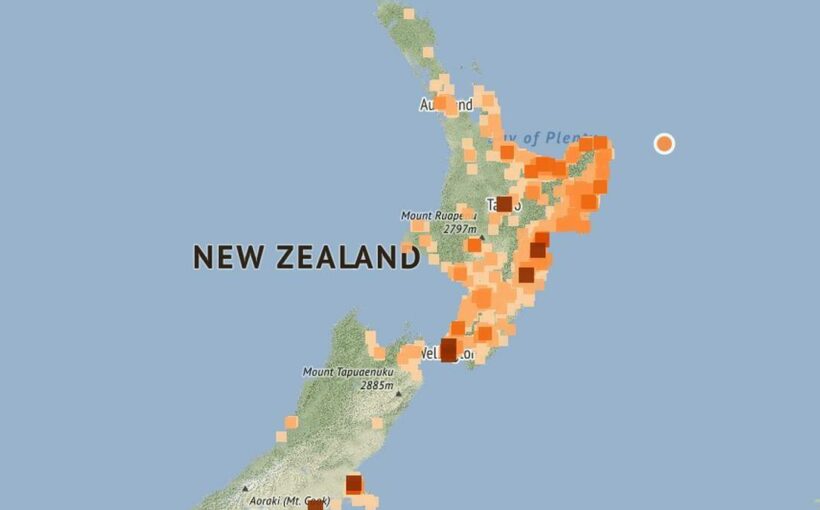Last night’s jolt was nearly the largest of nearly 3000 aftershocks recorded since the East Cape’s big 7.3 quake – but scientists say the sequence is playing out as expected.
As at this morning, GeoNet had recorded 2871 aftershocks since March 5, when a large and complex 2.27am quake struck about 125km east of Te Araroa.
That event was powerful enough to push parts of the East Cape and Hawke’s Bay about 1cm to the west and southwest, and trigger a sizeable sequence of aftershocks, with 17 so far measuring over 5.0.
Among them was a 6.2 quake that hit the following day, and a 6.1 event that was felt by around 7000 people when it erupted at 7.37pm last night, and just over a month later.
GNS Science duty seismologist Elizabeth Abbott described the sequence to date as “pretty typical” and said it wasn’t unexpected to see another quake larger than 6.0.
In its most recent aftershock forecast, GNS put the probability of one or more earthquakes of that size striking within the month at 25 to 30 per cent, and, within a year, as high as 60 to 70 per cent.
The forecast, generated using mathematical models, also predicted between nine and 13 more quakes over 5.0 within a year, but gave a nine to 12 per cent chance of anything stronger than 7.0 over the same period.
Abbott said the sequence appeared to be following a normal pattern of “decay”, whereby fewer aftershocks occurred as time went on, and the probabilities of large ones declined.
“The larger the earthquake, the longer you can expect the tail of events to be,” she said.
“If you’ve got a 7.0, you’re going to get more sixes in that sequence of events than if you had a 6.0.
“There are some rules of thumb that you can kind of follow, and I think most aftershock sequences in New Zealand tend to follow that.”
Throughout the first decade of the sequence that followed the 7.1 Darfield quake, GNS recorded nearly 1600 aftershocks – including the 6.3 February 2011 Christchurch Earthquake.
“I think we’ll see aftershocks for a long, long time in that part of the country,” she said.
“And just because the sequence is sort of decaying, and events are starting to get smaller, and maybe a bit more spread out, doesn’t doesn’t mean that we couldn’t get larger aftershocks.”
We could generally think of aftershocks as signs of readjustment along parts of a fault that slipped at the time of the initial “mainshock”.
“Every earthquake has an impact on the area surrounding it, and I think of aftershocks as the earth sort of settling itself back in, after a big shift.”
The March 5 event was an example of an “intraslab” earthquake, produced by internal stresses and strains that came with the Pacific plate being pushed down underneath the overlying Australian plate.
But how it unfolded was particularly complex, breaking two large faults in different locations, and at different depths.
“It was definitely a multi-source rupture that started deeper, and got shallower,” Abbott said.
“That’s been quite an interesting puzzle for scientists, and there’s been a lot of work done to understand exactly what happened.
“But a big thing for us, especially following Kaikoura, has been understanding that these multi-source events are not uncommon and do happen here.
“It’s something for us to be aware of when we model earthquakes, and likelihood of different levels of shaking around the country.”
But aftershocks themselves could also yield invaluable new information to scientists, as they acted as natural echo sounders to study the local structure of the earth.
Using them, seismologists and geologists can find the orientation of the fault plane, which helped enormously in characterising an earthquake, and the stresses and strains within the earth that caused it.
Still, it remained beyond impossible to predict exactly where and when each aftershock – or the aftershock of that aftershock – would strike.
After all, each one could be viewed as just one more earthquake changing the way stress is distributed underground, and sometimes even activating fresh spates of localised activity.
“It’s all part of one big chain of events, but I do think it’s reasonably common to see a number of smaller earthquakes following a bigger aftershock.”
For the public, she said the take-home message was aftershocks can – and will – happen.
“There can always be a sizeable aftershock, or another event that’s quite large, and we will expect shaking,” she said.
“And if it’s long and strong, you know what to do – stay away from the coast.”
Source: Read Full Article

/cloudfront-ap-southeast-2.images.arcpublishing.com/nzme/VHIJ7LEDGZKAMHNHDX6MHGD7WQ.jpg)